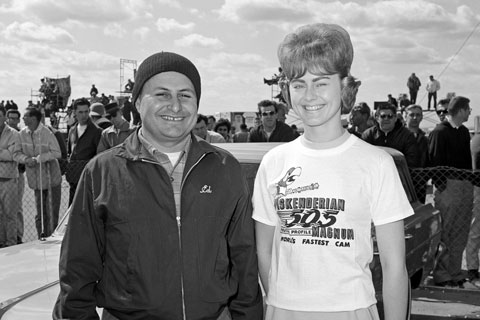SEMA News—May 2014
HERITAGE
Stu Hilborn
By Drew Hardin
Photo Courtesy Petersen Archives
 When Stu Hilborn passed away in December, the performance industry lost not only one of its most innovative minds but also an original hot-rodding pioneer.
When Stu Hilborn passed away in December, the performance industry lost not only one of its most innovative minds but also an original hot-rodding pioneer.
Hilborn was among those who raced on Southern California’s dry lakes in the years prior to World War II. Ironically for a man whose name is now synonymous with fuel injection, Hilborn had little mechanical knowledge when he bought his first hot rod in the ’30s. But he had a neighbor who did—Indy 500 veteran Eddie Miller. Miller helped Hilborn build a flathead-powered Model A that could hit 120 mph on the lakes, and Hilborn proved to be a quick study, in all senses of the word, and he soon wanted to go faster. To do so, he bought a narrow streamliner that had been raced by Bill Warth.
Hilborn picked up the ’liner on December 7, 1941, so he had only a couple of opportunities to run it before entering the Army Air Corps during World War II. While in the service, Hilborn began development of mechanical fuel injection, a system he tested on his streamliner once the war ended. He would swap the induction on the ’liner’s flathead back and forth between injection and multiple carbs, looking for peak miles per hour. During a carbureted test in August 1947, one of the car’s rear wheels collapsed, causing the ’liner to tumble several times at speed. Hilborn suffered back injuries that put him in a body cast. While he recovered, Eddie Miller Jr. rebuilt the racer.
Once out of the cast, Hilborn again went after high speeds on the lakes, though he had Howard Wilson drive the car (to keep a promise he made to his mother to not race again). The streamliner’s potential for speed caught the attention of the editors at the then-new Hot Rod magazine, which put it and Hilborn on the cover of just its fourth issue in April 1948. (The photo seen here is the one used for that cover.) At that time, the car was good for about 136 mph, but in July of that year, Wilson became the first to break the 150-mph barrier with a 150.5-mph pass across El Mirage.
It wasn’t long before Hilborn’s injection systems were in such demand that he had to give up racing to devote all his attention to what had become a new business. Many more race victories would follow, including 34 wins at Indianapolis and countless more at oval tracks, dragstrips and other racing venues all over the world. Hilborn was inducted into the SEMA Hall of Fame in 1996, and Hilborn’s Fuel Injection Engineering Co. still supplies dedicated enthusiasts with precise—and race-winning—fuel metering systems.






